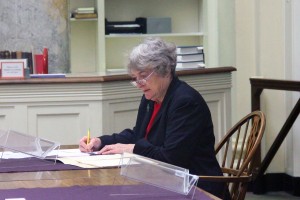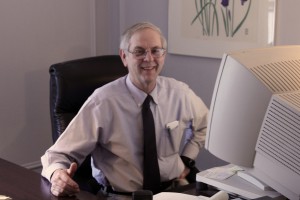The 200th annual meeting provided the opportunity to celebrate many accomplishments and transitions, but among the most poignant were the retirements of three long-time colleagues: Gigi Barnhill and Caroline Sloat (who retired this summer) and John Keenum (who will retire at the end of the year). A blog post about Gigi’s retirement will appear in Past is Present tomorrow, but I wanted to share with you the comments that I made at the annual meeting about Caroline and John.

Caroline Sloat officially joined the AAS staff in April 1993 as assistant editor, but she was a member of the AAS family for many years before that, both as a graduate student and as an Old Sturbridge Village staff member. And in that same vein, although she is now officially retired, I trust that she will continue to stay close as “kin.” John Hench always talked about Caroline’s skills as a substantive editor, but it was not until recently that I looked up the “book” definition of that term. As I found to be the case in almost everything he ever said, John was right about this, as well. It’s a term that fits Caroline to a T. The work that Caroline has always excelled at is the hardest kind of editing – one that must consider what the author was trying to say, whether or not it should be said or is worth saying, and then figure out – often with great diplomacy – how to help the author make their arguments more cogent, their language more clear, their writing more functional. And Caroline is legendary for offering this kind of substantive editorial assistance, not just on projects where she was assigned the task – such as AAS Proceedings, the History of the Book in America series, and the Gura book, she has offered the same sort of assistance to fellows working on their dissertations, journal articles, and books, just out of the goodness of her editorial heart. Caroline has devoted herself to making friends at the AAS and for the AAS, and the goodwill that she has engendered – evident in so many fellows reports over the years – is a debt that we could not easily repay except with our thanks for her years of service and devotion.

Almost from the time he arrived at AAS in 1996 to take up the post of vice-president for development, John Keenum has been saying to me, “I’m going to retire after the bicentennial,” and being a man of his word, that’s exactly what he’s doing. The one-room school house in the Berkshires to which John and his wife Katherine – a soon-to-be published writer of historical fiction — have long retreated on weekends and in August is now modernized, expanded, and ready for their year-round occupancy. I imagine them enjoying a long life there together, filled with books, concerts, dogs, and land-trust meetings, and I can’t imagine anyone more deserving of such repose. Raising money is a grind, although I’ve never seen one day in these sixteen years when John let that get the better of him. A consummate professional, John took every challenge we faced in his stride… and there HAVE been challenges. When he came we were still wrapping up the Mellon challenge for core operations, then we got an NEH challenge for acquisitions endowment. Next was the Kresge challenge for the building addition, then we needed to raise endowment to maintain things like the artists’ and writers’ fellowships that the Wallace grant once paid for, then there was the Mellon challenge for academic fellowships, and then yet another NEH challenge, this one for CHAViC. And thanks to his steadfast commitment to this institution, his dogged perseverance, his ability to finagle a budget (always on the up-and-up), and his ability to write beautifully cogent prose, under his leadership, AAS has met every one of those challenge propositions, securing the full amount offered as a challenge, often long before the deadline. John did all this, plus running the annual fund and being our federal grants officer, with precious little assistance. But John has done more than merely raise money for AAS. He has invested himself in the life of this institution, making friends with staff, fellows, and members alike, buying books for the collection, participating in volunteer projects, just to help out. He has been a simply wonderful colleague, greatly admired by all. He will also be greatly missed, but he leaves us a much richer organization for his having been here.

2 thoughts on “Celebrating the Retirements of AAS Staff Members”